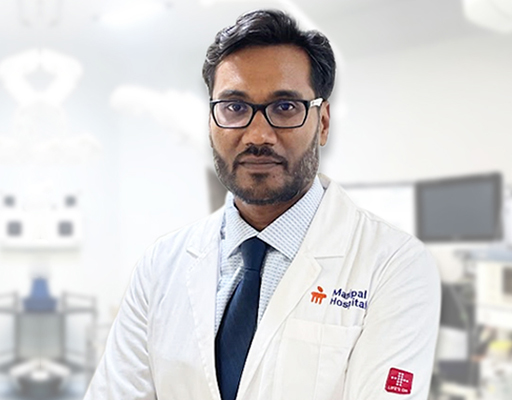
A Complete Guide About Robotic Hernia Surgery: Treatment, Conditions and Recovery
We believe minimally invasive care is life-enhancing care

A hernia, which takes place when an organ or a part of tissue protrudes through a hole in the muscle or the membrane, is a non-cancerous disease. Although some hernias do not necessarily develop life-threatening complications, not all hernias need surgical repair. The medical field has made significant progress recently, with robot-assisted hernia surgery leading the way. Robotic hernia surgery gives the surgeon the ability to operate with high accuracy and flexibility hence preferred by many.
In this comprehensive guide, we, at MH Robotic Surgery Clinic, will cover information about robotic hernia surgery for the treatment of inguinal and ventral hernias, various conditions, and aftercare.
How Is Robotic Hernia Surgery Defined?
Robotic hernia surgery is an endoscopic procedure where the surgeon controls a robotic system to fix a hernia. Contrary to what is known as conventional surgery which requires large cuts on the skin, muscles, and other tissues, this technique involves minimal cuts and therefore, less damage to the tissues, resulting in a shorter recovery period. In robotic laparoscopic hernia surgery, the surgeon manipulates robotic instruments that are very accurate and flexible in their operations.
To guide the robotic system, the surgeon uses a high-definition 3D camera, and the instruments allow the surgeon to maneuver in confined areas. This is particularly true for hernia repair, where surgery can be challenging in narrow spaces. Because of the application of robotics technology in surgeries, complications cases are few and surgeries are very precise.
Types Of Hernia That Can Be Treated With Robotic Surgery
Robotic hernia surgery deals with different kinds of hernias such as inguinal hernia, ventral hernia, or incisional hernia. Let’s explore the two most common types:
-
Inguinal Hernia
An inguinal hernia develops when the organs and tissues put pressure on a weak area in the muscles of the lower abdomen thereby resulting in the formation of a lump in the groin. The inguinal hernias are more frequently seen in men and are usually asymptomatic but may give rise to pain and life-threatening conditions in due course if left untreated. Regarding this type of hernia, robotic inguinal hernia repair is getting a preference in today’s world.
Robotic inguinal hernia repair also enables the surgeon to fix the problem more accurately making it difficult for the hernia to recur. The robotic system allows the surgeon to properly suture the mesh on the compromised region in a manner that shall not easily give in to the pressure of normal life activities.
-
Ventral Hernia
A ventral hernia happens when some tissue protrudes through the abdominal wall at any region of the mid-line. This can occur due to inherent deficiency in the muscle primarily resulting from making of surgeries, and pregnancy among other situations that exert stress on the abdominal wall muscles. Ventral hernias are relatively more challenging to fix than some of the other hernias, particularly by the size and placement of the damaged area.
Problems such as these make up these cases that surgeons can treat with special appreciation using robotic ventral hernia repair. The robotic instruments provide an extra dimension of control in the placement of mesh and sutures with a view of minimizing the chances of a reoccurrence of the hernia.
Why Robotic Surgery is Preferred for Hernia Repair
Robotic hernia surgery offers several advantages over traditional open or even standard laparoscopic surgeries:
- Smaller Incisions: Robotic surgery makes use of tiny ports; thereby resulting in smaller scars on the body surface and short hospital stays.
- Enhanced Precision: The endo wrist and robotic instruments help the surgeon to have better control and dexterity when moving the instruments around thereby enabling the surgeon to make precise movements, especially in constrained areas of the anatomy.
- Better Visualization: When using a high-definition 3D camera, the surgeons get to view the area they want to repair in the best possible light and this increases accuracy when fixing the region.
- Reduced Pain: As an added advantage, minimally invasive surgery reduces damage to the surrounding tissues hence a reduction in the amount of pain following the surgery.
- Faster Recovery: While benefiting the surgeon by allowing them to accurately carry a surgery through from start to end, robotic hernia surgery does offer some advantages to the patient who recovers much faster and resumes normal life earlier than the one that has undergone traditional surgery.
What You Should Expect Before Robotic Hernia Surgery
Robotic laparoscopic hernia surgery entails the surgeon to first assess the patient and make a report on their health. They will also need to determine the size and location of the hernia and other symptoms that one may have. If your condition is complicated, then your surgeon may recommend an ultrasound, computed tomography (CT) scan, or magnetic resonance imaging (MRI) to have a better view of the hernia.
After the decision that robotic hernia surgery is suitable for you, your surgeon will explain all the necessary preparations. This may comprise the particular foods and beverages to avoid, changes in medication, and the time required to abstain from food and liquid before the surgery.
The Procedure: How Robotic Hernia Surgery Works
When you are in the operating room, general anesthesia is administered to make you comfortable throughout the time of surgery. In performing the surgery, the surgeon will only make a few small cuts around the area of the hernia. These cuts are generally of a small measure referring to a centimeter to allow the installation of robotic tools as well as a scope.
The surgery is then performed by the surgeon sitting at the console, manipulating the robotic arms to sew the hernia. In inguinal hernia robotic surgery, the process essentially involves the pulling of the hernia sack back into place and a patch is placed over the area to prevent reoccurrence of herniation. In the same way, in robotic ventral hernia repair, the surgeon therefore fortified the abdominal wall with a mesh to enhance strength in the future.
Choosing the Right Surgeon
When it comes to robotic hernia surgery, then the right and most qualified robotics surgeon has to be chosen like Dr. Manjunath Haridas. A robotics surgeon is a doctor who has been trained to use robots in operations and contrasts the different procedures in benefit to the patient. What is important in choosing a surgeon, is how many operations with robotic systems have they conducted, how many hernia repairs were made successful, and other patients’ reports.
Some of the benefits that are often mentioned by patients who underwent robotic hernia surgery are the reduced hospitalization time, fewer days needed to recover, and better results which is why it is crucial to choose a doctor who uses it.
End Note
A surgical hernia performed by a robot is a great step in the development of the medical field, as the patient can be treated with an almost completely non-invasive method that is as effective as a traditional surgical hernia. Whether it is the inguinal or ventral hernia case, robotic surgery is safer, less painful, and results in faster healing as compared to traditional surgery. Hernias are among the surgeries that are increasingly being treated through less invasive approaches and robotic surgery is taking the lead as regards improved patient benefits. With this approach, which is common in today’s world, the patients are confident their conditions are correct and are being treated by the best technology available today. We, at MH Robotic Surgery Clinic, offer the best robotic surgery in India. So, get in touch with us today and book your appointment.



